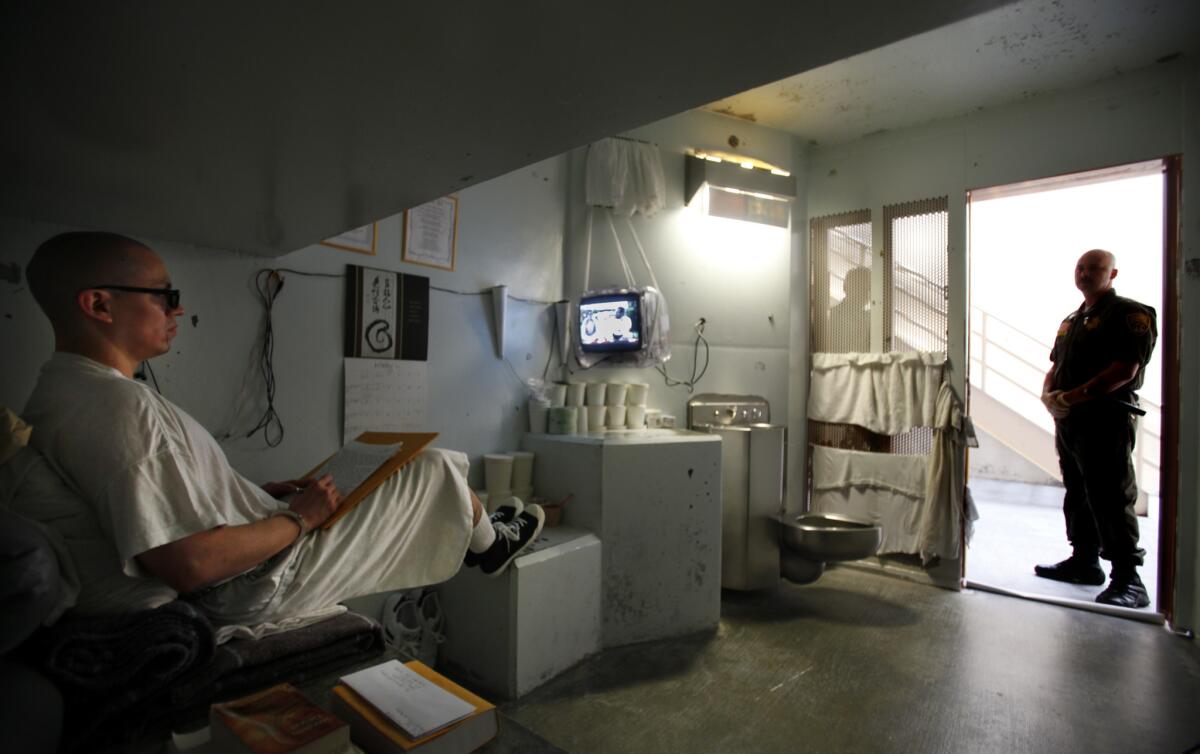From the Archives: Hunger strike in California prisons is a gang power play

A few hundred inmates are continuing to take part in a hunger strike in California prisons. Some prisoners claim this strike is about living conditions in the Security Housing Units, commonly called SHUs, which house some of the most dangerous inmates in California. Don’t be fooled. Many of those participating in the hunger strike are under extreme pressure to do so from violent prison gangs, which called the strike in an attempt to restore their ability to terrorize fellow prisoners, prison staff and communities throughout California.
I am concerned about the toll this hunger strike is taking on my staff, the inmates and their families. I am uneasy about what some inmates are telling my staff. Many say they want to resume eating but are afraid of the retaliation they will suffer at the hands of other inmates acting on orders from their gang leaders. In one prison, an inmate was assaulted because he refused to share his food with striking inmates. He suffered facial fractures and had to be hospitalized for several days.
For decades, California has had the most violent and sophisticated prison gangs in the nation. When gang violence exploded during the 1970s and 1980s, and crime rates around the state rose to record highs, state prisons felt the impact. Between 1970 and 1973, 11 employees of the California Department of Corrections and Rehabilitation were slain by inmates, and many others were brutally assaulted.
PHOTOS: Inside Pelican Bay State Prison
After this turbulent and violent time, and in response to the growing threat of gangs, the corrections department created SHUs to safely house gang members and their associates while minimizing their influence on other prisoners. Restricting the gangs’ communication has limited their ability to engage in organized criminal activity and has saved lives both inside and outside prison walls.
There are SHUs at four prisons in California. At three of them — in Tehachapi, Corcoran and Folsom — there are outdoor-facing windows in the cells that allow for direct sunlight. At Pelican Bay, all SHU cells have skylights. In all of the facilities, inmates in the SHU have radios and color TVs with access to channels such as ESPN. They have weekly access to a law library and daily exercise time. Many have cellmates; they can earn degrees; they can send and receive letters; and their family and friends can visit them every weekend. SHU inmates receive the same meals and portions as general population inmates. This is not “solitary confinement,” in that prisoners can have visitors and, in many cases, interaction with other inmates.
Even so, we remain committed to improving our facilities and policies. The department has brought in outside experts to evaluate our gang-management strategies. Based on their recommendations, we implemented a new comprehensive gang-management strategy last fall.
The new strategy places an emphasis on documented gang-related behavior, something hunger strike leaders asked for in 2011. It also features enhanced due process, along with a step-down program aimed at inmates who want out of the SHU but don’t want out of their gangs. We no longer commit people to indeterminate placements in SHUs, in which the terms have no end dates. And we are committed to providing less-restrictive housing and more privileges for inmates who demonstrate their willingness to refrain from gang behavior.
Also, as part of the reforms implemented last year, we are conducting case-by-case reviews of inmates who had been previously given indeterminate terms in SHUs. To date, we have completed 399 reviews, and about 62% of those whose cases have been reviewed have been transferred, or are about to be transferred back into the general prison population. An additional 30% were placed in various phases of the step-down program, receiving more privileges and rehabilitative services.
The corrections department has done everything it committed to do following the hunger strike in 2011. Several months after that strike, California’s Office of the Inspector General, which is responsible for independent oversight of the department, issued a report confirming the department’s good-faith efforts.
So what is this really about? Some of the men who participated in the last hunger strike have since dropped out of the gangs for religious or personal reasons, and they said it best in recently filed court declarations. “Honestly, we did not care about human rights,” one inmate said about the 2011 hunger strike. “The objective was to get into the general population, or mainline, and start running our street regiments again.” Another described the hunger strike this way: “We knew we could tap big time support through this tactic, but we weren’t trying to improve the conditions in the SHU; we were trying to get out of the SHU to further our gang agenda on the mainline.”
It’s no different this time. The inmates calling the shots are leaders in four of the most violent and influential prison gangs in California: the Aryan Brotherhood, the Mexican Mafia, Nuestra Familia and the Black Guerrilla Family. We’re talking about convicted murderers who are putting lives at risk to advance their own agenda of violence.
The leaders of these four gangs are directly responsible for at least five ruthless murders, 35 violent assaults, including stabbings, and they have racked up more than two dozen violations for possession of weapons and other contraband.
Brutal killers should not be glorified. This hunger strike is dangerous, disruptive and needs to end.
Jeffrey Beard heads the California Department of Corrections and Rehabilitation.
More to Read
A cure for the common opinion
Get thought-provoking perspectives with our weekly newsletter.
You may occasionally receive promotional content from the Los Angeles Times.










